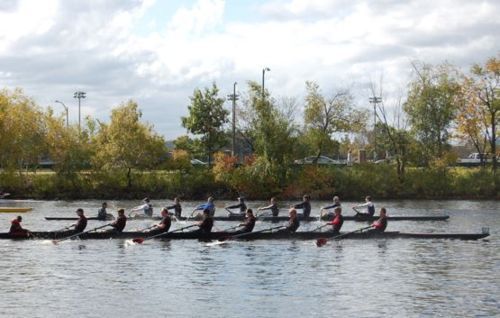
It looks to me as if the starboard side of this boat is not in sync. I took the photo at The Head of the Charles Regatta a couple of years ago. You can see splash behind the oars of the number 3 and 5 oarsmen (number one is at the bow, where I rowed in high school). But the bowman has no splash visible, which makes it appear as if he has not completely finished the stroke yet. It’s a very slight departure from perfect timing, and I’m sure I would not have spotted it with my naked eyes from the banks of the river.
Marshall McLuhan at page 193 of Understanding Media notes that the photograph is useful for collective postures and gestures, whereas written and printed language is biased toward the private and individual. ”Moreover,” he adds on the next page, “that the photograph is quite versatile in revealing and arresting posture and structure wherever it is used, occurs in countless examples, such as the analysis of bird-flight.” Or crews.
This is part of McLuhan’s larger point that photography and movies “restoredgesture to the human technology of recording experience.” He posits that this restoration, which followed the severing of the spoken word from its aspects of sound and gesture through the phonetic alphabet, enabled Freud and Jung to identify “collective postures of the mind with which the written form could not cope.”
I plan to row later this morning if the rain holds off. From my window, I can see that the river is as calm as green glass. A red boat slices downstream, powered by a pair of rowers. I didn’t take a photo, so I can’t tell you much about their collective posture.
When I row on the Charles, my mind sits upright, alive with memories of my earliest rowing days, nearly 50 years ago. I also carry with me images by the painter Thomas Eakins, whose early work included a painting titled “Max Schmitt in a Single Scull.” A poet friend of mine, Philip Dacey, wrote a wonderful collection of poems titled The Mystery of Max Schmitt: Poems on the Life and Work of Thomas Eakins. A fellow member of the Cambridge Boat Club, Craig Lambert, has written a luminous meditation on rowing titled Mind Over Water: Lessons on Life from the Art of Rowing, that I’m about a third of the way through on my Kindle.
McLuhan writes:
In fact, the snapshot of arrested human postures by photography directed more attention to the physical and psychic posture than ever before.
If you happen to be on the Longfellow Bridge as I sweep beneath it in a CBC club single in a couple of hours, please feel free to take a photo and email it to me at PodChronicles AT Gmail DOT com. I could certainly benefit from paying more attention to my physical and psychic posture.
 Send to Kindle
Send to Kindle